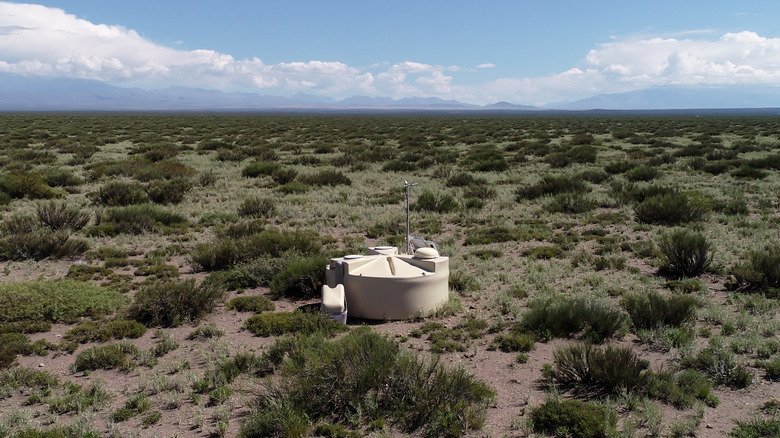Why Scientists Haven't Solved The Mystery Of The Oh-My-God Particle
Below the snow-covered peaks of the Andes Mountains, among scattered rocks and the scrub of prairie bushes, there sits at this very moment a 12-ton polyethylene tank holding 3,000 gallons of pure water. All around it, spread out in every direction over an area nearly the size of Rhode Island, are 1,599 more such tanks, each identical to the first. These lonely sentinels have their eyes on the sky, patiently observing what human eyes cannot in the hopes of solving a mystery that began on another continent and more than three decades prior — a mystery that started with the Oh-My-God event.
It was the night of October 15, 1991. The University of Utah had set up an experimental observatory called the Fly's Eye in the isolation of Dugway Proving Ground, a sprawling 800,000-acre tract of land used by the U.S. Army to test biological and chemical weapons since the 1940s. On that night the Fly's Eye detected something called an air shower, a miles-long explosion of streaming particles invisible to the human eye and caused by high-energy interactions in the upper atmosphere.
Scientists looked at the data they'd collected and worked backward to deduce the properties of the space-borne particle that led to the air shower. The results weren't just shocking — they were thought to be impossible. They called their discovery the Oh-My-God particle.
Cosmic rays
Radiation is a phenomenon that scientists only began to understand in the late 19th century. Many chemical elements have radioactive isotopes, and a good place to find a variety of elements is the Earth itself, so it's no surprise that scientists at that time measured consistent levels of radiation at the Earth's surface and decreasing amounts several feet in the air: radiation originates from the Earth. Then, in 1912, someone took a detector a few miles up into the atmosphere using a hot air balloon — as was the fashion at the time — and found that above a certain height, radiation levels began increasing again. It meant that there must be another source of radiation — not from the Earth, but from space. We now refer to this space radioactivity as "cosmic rays."
Cosmic rays come from every direction and bombard the Earth constantly — in fact, they're a major obstacle to human space exploration. Luckily the magnetosphere and the thin layer of air around the Earth keep most of this radiation from reaching the surface. Cosmic rays are usually single protons or light atomic nuclei, but some can be as heavy as iron, and they're believed to frequently originate from supernova explosions within the Milky Way.
As one might expect, lower-energy cosmic rays are observed more frequently, while cosmic rays with extremely high energies are also extremely rare. It was long believed there was a maximum possible energy a cosmic ray could contain. The Oh-My-God particle was measured to exceed this limit by 500%
OMG levels of power
The scientific consensus seems to suggest that the subatomic world is pretty darn small. Laughably, unfathomably small. It wouldn't make sense to describe atomic physics in terms of miles or grams or joules because those standards are only useful in the macro-world of humans. Instead, the observations of the very (very) tiny are described in terms of angstroms and electronvolts and other such conventions. Not so for the Oh-My-God particle.
When the Oh-My-God particle slammed into the Earth's atmosphere, it was traveling many orders of magnitude faster than 99.99% the speed of light — suffice it to say that there isn't room here for all the extra point-999s — and the resulting collision released 320 exaelectronvolts of energy. It's such a ridiculous number that we need macro-world conventions to describe it: 48 joules of energy.
Bear in mind that this is a subatomic particle we're talking about. This unimaginably small particle hit with the force of a standard tennis ball traveling at over 90 miles per hour. To put it another way, Space.com reports that the Oh-My-God particle exceeded the energy output of the Large Hadron Collider by a factor of 10 million. With a little (bad) luck, that's a potentially lethal punch from something 100,000 times smaller than a single atom. OMG indeed. That being said, it would sure be nice to know where the Oh-My-God particle came from.
What's the problem?
Cosmic rays this powerful were thought to be impossible. The reason for this is the cosmic microwave background, or CMB. For practical purposes, it makes sense to think about outer space as being essentially empty. But in the sneaky and strange world of the subatomic, space is not empty. Instead, it's filled with low-energy photons. These photons are the CMB, or the dim glow that still persists from the cataclysm that was the big bang. Think of the CMB like the early morning embers of last night's bonfire; it's not a raging inferno, but it's still giving off just a little heat.
The universe contains some pretty powerful phenomena — things like quasars and gamma-ray bursts. Powerful cosmic phenomena frequently have powerful magnetic fields, which can accelerate particles to ridiculous speeds. The problem is that these accelerated particles can't get very far — in astronomical terms, anyway — before being slowed down by the CMB to speeds that are admittedly still incredibly fast, but not OMG-fast.
This leaves scientists with a dilemma. Based on the measurements of the Oh-My-God particle's speed, it had to have originated from relatively nearby (again, in astronomical terms). But the only natural events and objects powerful enough to create the Oh-My-God particle are so big and so energetic that we would already know if we had one in our cosmological backyard, and we haven't found anything yet that fits the bill. So then where in the world did this thing come from?
Unsolved mysteries
The answer: nobody knows. While the Oh-My-God particle still remains the most energetic cosmic ray ever detected, a handful of others in the off-the-scales range have been observed in the years since, confirming that it wasn't a miscalculation or instrumentation failure, but in fact a real event. This is why 1,600 giant water-filled tanks have been installed in a grid formation across 3,000 square kilometers of the arid Mendoza region of Argentina. These are the specialized detectors of the Pierre Auger Observatory, forming an array designed to capture evidence of other extremely high-energy cosmic rays.
What's more, evidence so far seems to show that these extreme cosmic rays are approaching Earth from every direction. This indicates that whatever is producing highly energetic cosmic rays is not a single source, but many independent objects that very much have the Earth surrounded. Did the Oh-My-God particle come from a supermassive black hole? Colliding neutron stars? Something stranger? The answer is certainly out there somewhere — we'll just have to keep looking.




